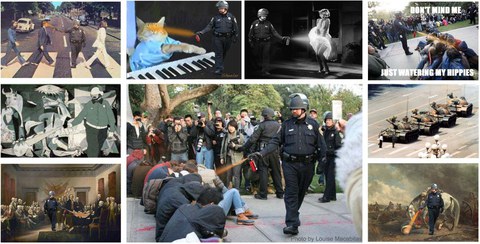Jan 20, 2022
Internet memes, videos of police violence and protests on social media

Photoshop Meme „Pepper Spraying Cop“, Fotografie während der Occupy-Proteste UC Davis 2011 und Meme-Varianten im Netz
Who hasn't seen them: images of demonstrations, videos of violence or internet memes of politicians that are circulating on social networks. What role do these images play in protests? Do they trigger the action, do they merely document the events or are they themselves to be understood as actors?
Prof. Kerstin Schankweiler, Chair of Visual Culture in the Global Context, Dr. Verena Straub and Tanja-Bianca Schmidt are investigating these and other questions in the DFG research project: "Image Protests on Social Media: Internet Memes, Videos of Police Violence and References to Art".
"The aim of the project is to investigate the significance of images in social media protests," explains Prof. Kerstin Schankweiler. "We want to show that political protest cultures around the world relate to each other and develop transnational visual practices, aesthetics and genres. However, we must also take into account that image protests are shaped by local contexts and are steered by geopolitical and economic power structures."
Three sub-projects are dedicated to this topic. Sub-projects 1 and 2 deal with internet memes in political contexts and videos of police violence. Both are two particularly virulent examples of image protests in social media. On a higher level, sub-project 3 focuses on the appropriation and reflection of these image protests in contemporary art. This focus makes it possible to analyze three very different, yet central aspects of digital image protests and their reciprocal relationships.
One example is the meme that became known as the "Pepper Spraying Cop", which was appropriated and disseminated en masse online from 2011 onwards. The meme was created in response to a documented case of police violence, when a police officer attacked "Occupy" demonstrators with pepper spray in front of a US university in an almost casual gesture. The biting image-text montages that were subsequently shared on social media defamed the police officer's action, but also placed it in an ironic context with images from pop culture and art history. The aim of the project is to describe the momentum and ambivalence of such image protests, whose political intentions are sometimes difficult to grasp.
In addition to the current view of the image protests, the project also pursues a historical perspective. "We hope that this perspective will help us to investigate the extent to which digital image practices of protest are linked to comparable practices in the history of art and visual culture in the 20th century," explains Dr. Verena Straub, "and the extent to which the specific nature of the new image economies in social networks has led to a radical reconfiguration of political image protests."
In addition to the content-related work, the researchers also want to try out new digital methods for research and thus develop an innovative mix of methods for the image-based research of social media content.
The project started at the beginning of this year and will be funded by the German Research Foundation (DFG) for three years.
Information for journalists:
Prof. Kerstin Schankweiler
Chair of Visual Culture in the Global Context
Phone: +49 351 463-35710
Dr. Verena Straub
Co-project leader of the DFG project
verena.straub@tu-dresden.de
